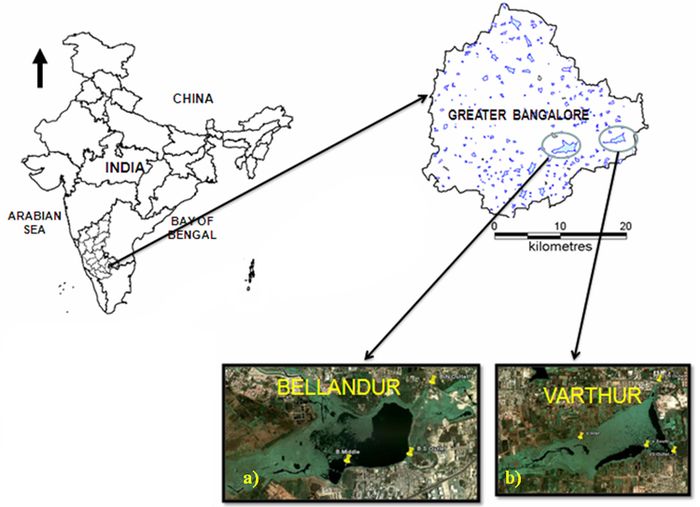1 Centre for Sustainable Technologies,
2 Centre for infrastructure, Sustainable Transportation and Urban Planning, 3 Centre for Contemporary Studies,
4 Energy and Wetlands Research Group, Centre for Ecological Sciences, Indian Institute of Science, Bangalore 560 012, India E-mail: durgamadhab@ces.iisc.ac.in, chanakya@cst.iisc.ac.in, cestvr@ces.iisc.ac.in Materials and Methods Study Area Varthur Lake is the second largest fresh water body in Bangalore built by the Ganga Kings over a thousand years ago [Figure 1. b)] for domestic and agricultural uses. It is 5 km downstream of Bellandur lake receiving the discharge from Bellandur lake and an additional sewage from inflows from near by areas. The Varthur lake catchment has seen large scale land use changes after 2000, consequent to the rapid urbanization in the region. The lake receives 595 million liters per day (MLD) of sewage. The sampling locations are shown in the Figure 1. Table 1 shows the characteristics of the studied lakes.
Table 1. Characteristics of the Study area
Experimental Design Water samples from 10cm below the surface were collected from the inlet, middle and outlets representing the inflow and the outflows of the lake. Parameters like pH, temperature, electric conductivity were analysed on-site with appropriate probes. Dissolved Oxygen, free Carbon dioxide and other physico-chemical analyses were carried out following standard methods (APHA, 1995). Algal samples from water were collected with the help of Planktonic net in 100 ml polythene bottles and were preserved in 70% alcohol. Algae attached to aquatic plants and stones (biofilms) were also collected in separate containers. With the help of a pipette, samples were mounted on the slide and observed under the microscope for enumeration. Images were captured using Caliper pro software and DIP microscope. Algae were identified till genus level following Taylor et al., 2006 and 2007 and their community structure were observed. The relative abundance of algal communities was examined. The bacterial count and density were analysed by Flow Cytometer (FACS Caliber) and were verified with microscopy. The bacterioplankton population was analysed by first filtering the lake samples with 40 μm and 2.5 μm sieve and then by the FSC (forward scatter) plots. The nutrient content (C and N) of the phytoplankton, bacterioplankton and macrophytes were measured with CHN analyzer (TRUE SPEC CHN, 1.9X, LECO). Citation: Durga Madhab Mahapatra, Chanakya H. N and T. V. Ramachandra, 2011, Water treatment potential in relation to phytoplankton dynamics in tropical sewage-fed urban water bodies. Proceedings of the Conference on Microbes in Wastewater and Waste Treatment, Bioremediation and Energy Production, January 24-27, 2011, Goa, India.
|
||||||||||||||||||||||||||||||||||||||||||||||||||||||||||


